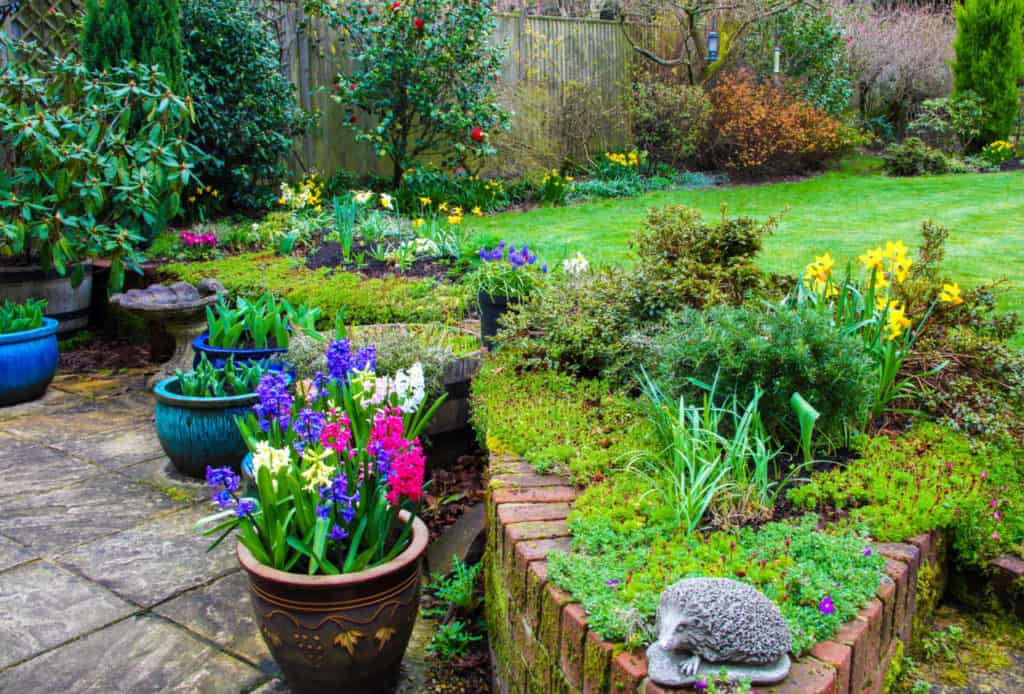
By Leonard Perry, UVM Horticulturist and Charlie Nardozzi, garden consultant
Proper planting of containers, sowing greens, and pruning woody perennials are some of the gardening activities for this month.
Container gardening remains a hot trend. When planting large containers for the deck or patio, save on soil by creating a false bottom. Most of the plants you’ll use don’t need more than about a foot of soil depth for their roots, so put some empty plastic soda or water bottles in the very bottom, then cover with landscape fabric or a piece of cardboard cut to fit to keep the soil from eroding. Plastic pots turned upside down also work, as do coarse and inexpensive wood shavings. Some use those Styrofoam packing “peanuts” (put in plastic bags so they’re easily handled and contained).
Unless you have one large plant in a large pot, such as a tomato (there are compact ones now for smaller containers), you’ll be combining several plants. For large pots such as barrel halves, think about a special plant for a “thriller”, others for “fillers”, and finally some “spillers” cascading over the pot sides. Examples might be an ornamental fountain grass or tall purple salvia for thriller, petunias for fillers, and lantana or blue fan flower for spillers.
If you’ve planted enough plants to fill the pot (allow room for some growth when planting), roots will fill the soil by mid-season and plants will need frequent watering. This is especially true for hanging baskets, with both container and plants exposed to drying wind. To keep plants from wilting and lessen your need to water more than once every day or two, incorporate a water-absorbing product (usually granules or beads) into the soil when planting. These hold many times their weight in water, releasing it over time to the plants.
Also, make sure containers have holes in the bottom so excess water can drain. Otherwise, a waterlogged soil will rot the roots and kill the plants. If your plants are wilted, but the soil is really wet, check to see if the pot has drainage holes, and that they are not plugged.
To get a head-start on fresh greens, sow seeds in a large, shallow container. Keep the container outside during the day and bring it in at night if the temperatures dip below freezing, or protect it in a cold frame. A window box with colorful greens is not only ornamental, but makes for easy picking and protection from hungry rabbits.
Woody perennials differ in the way they should be cut back in spring. If butterfly bush has died to the ground, cut the dead stems to the ground. Otherwise just shorten them by about one third. Cut back Russian sage, rue, and artemisias to about 8 to 12 inches from the ground. Don’t prune lavender until new growth appears, and then just shorten the stems by about one-third. Heather should be lightly pruned to remove the old flowers and the tips of the shoots, but don’t cut back to brown wood, stay in the green. Wait until rose shoots and leaves emerge to prune, in order to know what stems died and which are living.
Now that spring is finally near, there is so much more you can do outdoors. Prune any tree or shrub branches that may have been injured or broken over winter by heavy snow and ice. If you want to prepare garden beds ready to plant, or to divide perennials, make sure to not work soil while it is still wet, or you will destroy its structure. If you haven’t tested your soil in a year or two, now is a good time. Soil test kits are available from many complete garden stores. State universities (through Extension offices) offer quite accurate soil test kits and recommendations.
This article was distributed and first published in the Mountain Times, April 2019. Charlie Nardozzi is a nationally known horticulturist, author, gardening consultant, and garden coach (gardeningwithcharlie.com). Distribution of this release is made possible by University of Vermont and the Vermont Nursery and Landscape Association, Green Works.




